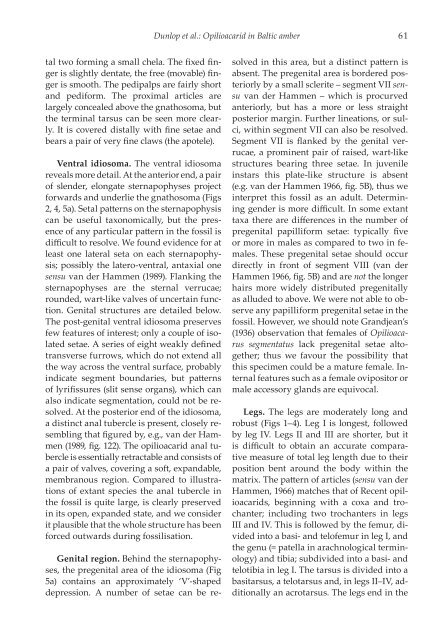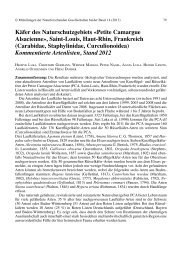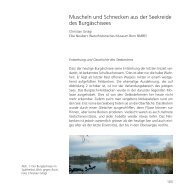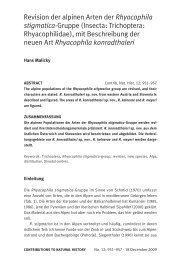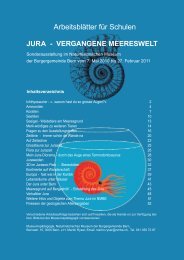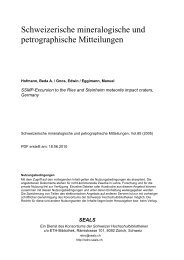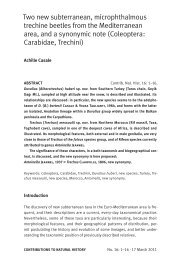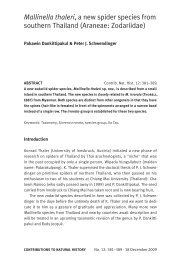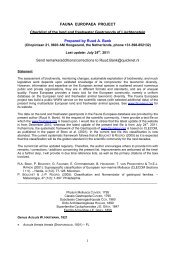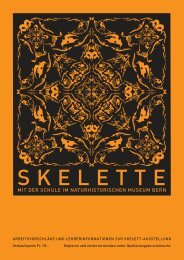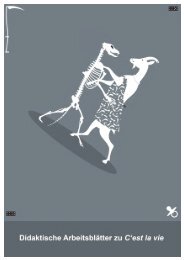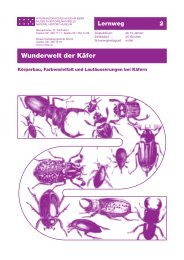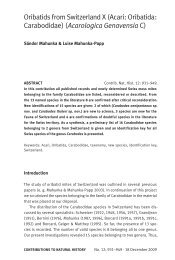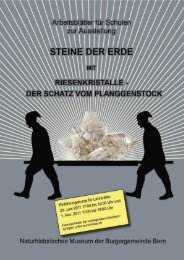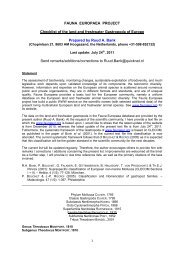Opilioacarus aenigmus Dunlop, Sempf & Wunderlich
Opilioacarus aenigmus Dunlop, Sempf & Wunderlich
Opilioacarus aenigmus Dunlop, Sempf & Wunderlich
Create successful ePaper yourself
Turn your PDF publications into a flip-book with our unique Google optimized e-Paper software.
tal two forming a small chela. The fixed finger<br />
is slightly dentate, the free (movable) finger<br />
is smooth. The pedipalps are fairly short<br />
and pediform. The proximal articles are<br />
largely concealed above the gnathosoma, but<br />
the terminal tarsus can be seen more clearly.<br />
It is covered distally with fine setae and<br />
bears a pair of very fine claws (the apotele).<br />
Ventral idiosoma. The ventral idiosoma<br />
reveals more detail. At the anterior end, a pair<br />
of slender, elongate sternapophyses project<br />
forwards and underlie the gnathosoma (Figs<br />
2, 4, 5a). Setal patterns on the sternapophysis<br />
can be useful taxonomically, but the presence<br />
of any particular pattern in the fossil is<br />
difficult to resolve. We found evidence for at<br />
least one lateral seta on each sternapophysis;<br />
possibly the latero-ventral, antaxial one<br />
sensu van der Hammen (1989). Flanking the<br />
sternapophyses are the sternal verrucae;<br />
rounded, wart-like valves of uncertain function.<br />
Genital structures are detailed below.<br />
The post-genital ventral idiosoma preserves<br />
few features of interest; only a couple of isolated<br />
setae. A series of eight weakly defined<br />
transverse furrows, which do not extend all<br />
the way across the ventral surface, probably<br />
indicate segment boundaries, but patterns<br />
of lyrifissures (slit sense organs), which can<br />
also indicate segmentation, could not be resolved.<br />
At the posterior end of the idiosoma,<br />
a distinct anal tubercle is present, closely resembling<br />
that figured by, e.g., van der Hammen<br />
(1989, fig. 122). The opilioacarid anal tubercle<br />
is essentially retractable and consists of<br />
a pair of valves, covering a soft, expandable,<br />
membranous region. Compared to illustrations<br />
of extant species the anal tubercle in<br />
the fossil is quite large, is clearly preserved<br />
in its open, expanded state, and we consider<br />
it plausible that the whole structure has been<br />
forced outwards during fossilisation.<br />
Genital region. Behind the sternapophyses,<br />
the pregenital area of the idiosoma (Fig<br />
5a) contains an approximately ‘V’-shaped<br />
depression. A number of setae can be re-<br />
<strong>Dunlop</strong> et al.: Opilioacarid in Baltic amber 61<br />
solved in this area, but a distinct pattern is<br />
absent. The pregenital area is bordered posteriorly<br />
by a small sclerite – segment VII sensu<br />
van der Hammen – which is procurved<br />
anteriorly, but has a more or less straight<br />
posterior margin. Further lineations, or sulci,<br />
within segment VII can also be resolved.<br />
Segment VII is flanked by the genital verrucae,<br />
a prominent pair of raised, wart-like<br />
structures bearing three setae. In juvenile<br />
instars this plate-like structure is absent<br />
(e.g. van der Hammen 1966, fig. 5B), thus we<br />
interpret this fossil as an adult. Determining<br />
gender is more difficult. In some extant<br />
taxa there are differences in the number of<br />
pregenital papilliform setae: typically five<br />
or more in males as compared to two in females.<br />
These pregenital setae should occur<br />
directly in front of segment VIII (van der<br />
Hammen 1966, fig. 5B) and are not the longer<br />
hairs more widely distributed pregenitally<br />
as alluded to above. We were not able to observe<br />
any papilliform pregenital setae in the<br />
fossil. However, we should note Grandjean’s<br />
(1936) observation that females of <strong>Opilioacarus</strong><br />
segmentatus lack pregenital setae altogether;<br />
thus we favour the possibility that<br />
this specimen could be a mature female. Internal<br />
features such as a female ovipositor or<br />
male accessory glands are equivocal.<br />
Legs. The legs are moderately long and<br />
robust (Figs 1–4). Leg I is longest, followed<br />
by leg IV. Legs II and III are shorter, but it<br />
is difficult to obtain an accurate comparative<br />
measure of total leg length due to their<br />
position bent around the body within the<br />
matrix. The pattern of articles (sensu van der<br />
Hammen, 1966) matches that of Recent opilioacarids,<br />
beginning with a coxa and trochanter;<br />
including two trochanters in legs<br />
III and IV. This is followed by the femur, divided<br />
into a basi- and telofemur in leg I, and<br />
the genu (= patella in arachnological terminology)<br />
and tibia; subdivided into a basi- and<br />
telotibia in leg I. The tarsus is divided into a<br />
basitarsus, a telotarsus and, in legs II–IV, additionally<br />
an acrotarsus. The legs end in the


